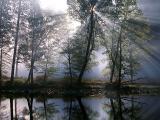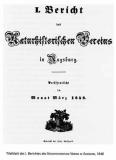History
The society was founded as “Naturhistorischer Verein Augsburg“ in 1846 by 19 citizen of Augsburg. In 1886, the original name was replaced by its today’s name “Naturwissenschaftlicher Verein für Schwaben“. Ten years after its foundation, the society already comprised 500 members. This was really a lot since Augsburg had only around 40.000 residents at that time. Among the members were (and still are) people of various backgrounds, especially physicians, pharmacists, manufacturers, public servants as well as traders and clergymen of different denominations.
The first issue of the societies own report (later called “Berichte des
Naturwissenschaftlichen Vereins für Schwaben“) appeared in 1848. Therefore our publication activity lasts more than 150 years. Today, the report appears once a year and includes many articles presenting the most important findings of its members. In addition, the report is often complemented with special publications such as books that were written by members.
It was also in 1848 when Dr. med. Körber, the chaiman at that time, announced the major goal of the society namely the advancement of natural scientific studies and knowledge about the natural resources of the Augsburg area. This was the starting point for setting up a unique collection of natural objects including plants, animals and minerals that mainly stem from the Augsburg area. As the size of this collection grew rapidly and with the help of some influential citizen of Augsburg it could be transferred to the former evangelical orphanage in 1854. The first museum of natural history of Augsburg appeared. From then on a lot of people came to visit this unique collection each year. Among the visitors were Maximilian I., king of Bavaria, as well as the famous naturalist Afred Brehm.
It was also at that time when members like the botanist Friedrich Caflisch, the entomologist Christian Friedrich Freyer, the ornithologist Johann Friedrich Leu and the paleontologist Dr. Otto Roger published the results of their pioneering work in our reports.
Over the years the size of the collection grew steadily and there was no space left to accommodate new objects. Therefore, in 1904 the museum was relocated to a bigger building, the former Stettenhaus. Due to the scientific activity of our members the collection extended to one of the most comprehensive ones at that time. Unfortunately, Augsburg was heavily destroyed in the night of bombing (25th to 26th of February 1944) during the Second World War. In this night almost all of the unique objects were lost.
After the Second World War, the society recovered rapidly. Members like the botanist Dr. Hermann Ziegenspeck, the entomologist Dr. Heinz Fischer, the ornithologist Dr. Walter Wüst, the biologist Dr. Wilhelm Issel and finally the botanist Dr. Ernst Nowotny launched an era that was characterized by intensive scientific studies. In the second half of the 20th century, Prof. Dr. Hermann Oblinger and Dr. Fritz Hiemeyer headed the society very successfuly. Together with Lorenz Scheuenpflug, Georg Radmüller, Dr. Georg Steinbacher and Johann Stangl several groundbreaking studies could be performed that contributed to the excellent reputation of the Naturmuseum Augsburg.
Due to our persistent efforts, the museum (now officially called: “Naturmuseum Augsburg“) could be relocated to a new building in 1991. The traditional interconnection of the museum with our society lasts until today.
In 1996, the society celebrated its 150th anniversary in the Golden Hall (“Goldener Saal“) that is located in the beautiful city hall and represents one of the landmarks of Augsburg. Part of the celebration was also a lecture given by Prof. Dr. Wolfgang Seiler (Fraunhofer Institute, Garmisch-Partenkirchen), an established climate researcher. He spoke about the climate change and the consequences associated with this phenomenon. This lecturer was chosen to emphasize the willingness of our society to tackle the big questions that will decide our future in a responsible manner.






